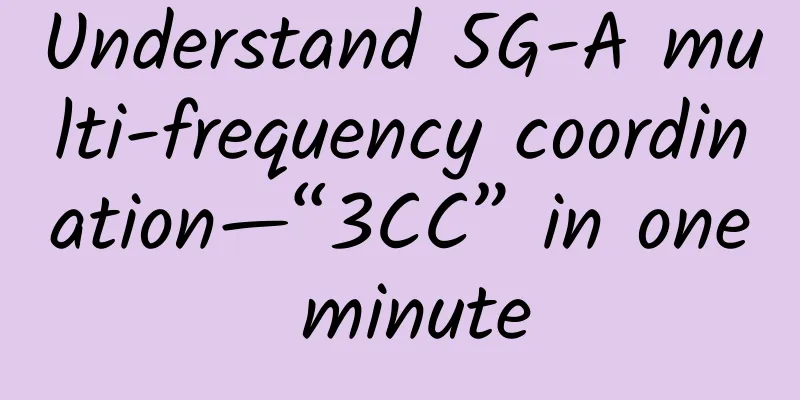Understand 5G-A multi-frequency coordination—“3CC” in one minute

|
picture Speaking of "3CC", we must mention its more popular name - "3 legs". In the communications industry, we often talk about the concepts of "adding legs" and "deleting legs". So, what are "legs"? The "legs" are actually the communication carrier frequency bands. The "three legs" contained in 3CC correspond to three component carriers (CC), such as 2.1G/3.4G/3.5GHz. picture The combination of three component carriers of 3CC is also called "T+T+F". Naturally, there must be 2CC corresponding to 3CC. There are many combinations of 2CC, the most common ones are "F+F, F+T and T+T".
picture First of all, as to why 3CC is used, it must be because a single carrier has some disadvantages. We all know that the frequency bands used by 5G are relatively high, such as 4.9GHz and 3.5GHz, which belong to the medium and high frequency bands. The advantage of high frequency bands is that the bandwidth resources are large, but the corresponding transmission loss is also higher and the penetration loss is greater. For example, the path loss of 3.5GHz is about 4.4dB higher than that of 2.1GHz. This leads to a shorter coverage distance and insufficient coverage depth of a 5G single carrier. This is reflected at the user level in the low cell edge rate, poor network performance, and poor perception. For places with dense traffic, such as high-speed rail stations, airports, and central business districts, there are many partition scenarios. When outdoor macro base stations are used for coverage, the penetration loss is relatively large. Elevators, underground parking lots, and other areas in such scenarios are generally blind spots. In addition, the bandwidth of the FDD frequency band is generally small. For example, the bandwidth of 2.1GHz is only 40M, which is insufficient compared to the 100M of TDD-3.4/3.5GHz. We all know the principle of "1+1+1>1". 3CC can combine three carriers to achieve a bandwidth of more than 200M+, which is much higher than a single carrier in terms of speed and capacity. It can effectively improve the coverage distance and coverage depth, and maximize user perception. picture picture 3CC is based on traditional carrier aggregation technology (CA), which aggregates two or more component carriers to obtain a larger bandwidth. After the UE is configured with carrier aggregation, it can send and receive data with multiple cells at the same time, deeply coordinate high and low frequency multi-carrier capabilities, and further improve the user's perceived rate and experience. picture
picture In April 2021, ZTE took the lead in completing the DL 3CC CA verification of 2.1G+3.4G+3.5G, and the single-user peak rate increased by 226% compared with the 3.5GHz single carrier. In 2024, ZTE will conduct field performance testing and verification of 3CC, and cooperate with operators to create key coverage scenarios for 3CC contiguous areas. In March 2024, ZTE conducted a 3CC contiguous area test in a certain bureau, and its indoor depth coverage was increased by up to 15%+, and the indoor edge rate was increased by 110%+; the outdoor downlink road rate was increased by 50%+. ZTE will continue to cooperate with operators to create a high-speed experience in 3CC contiguous areas, further improve network performance, and provide users with a better perceived experience. picture picture picture |
<<: Interviewer: Can you tell me why TCP needs three handshakes and four waves?
>>: The importance of 5G for manufacturing robots
Recommend
[6.18] CMIVPS recharge gift 20%, Hong Kong high bandwidth VPS monthly payment 20% off / annual payment 30% off
CMIVPS has launched a special promotion for 6.18....
Explore the unlimited potential of 5G technology
Information technology experts and economists hav...
New iCONNECT, SD-WAN 3.0 architecture, launched
The Lingrui Lanxin iCONNECT SD-WAN 3.0 product la...
Wireless AP Capacity and Network Bandwidth Calculation Method
Wireless AP is the access point for users to ente...
iOVZ Valentine's Day Promotion: 30% off all VPS/50% off Korean dedicated servers, Los Angeles/Korea VPS monthly payment starts from 42 yuan
iOVZ has just launched a Western Valentine's ...
MaxCompute Spark resource usage optimization
1. Overview This article mainly explains MaxCompu...
2017 is the turning point year with three main investment themes: 5G, Internet of Things and optical communications
[[179940]] In 2017, the capital expenditure of gl...
HTTPS learning summary
Preface I've been reading about HTTP recently...
Building a cloud foundation to connect the world | Ruijie Networks presents cutting-edge products at the 2021 PT Expo
On September 27, 2021, the 30th China Internation...
Gartner predicts that global spending on 5G network infrastructure will double by 2020
[[336113]] Recently, according to Gartner's l...
Huawei's Meng Wanzhou: 5.5G is the inevitable path for 5G network evolution
On June 28, 2023 MWC Shanghai opened, and Huawei ...
It's 2021, what is the real experience of IPv6? A programmer tells his personal experience
[[428843]] Since the issuance of the "Action...
Huawei's Rotating Chairman Guo Ping speaks at the Global Analyst Conference: Overcoming difficulties and moving towards the future
[Shenzhen, China, May 18, 2020] Huawei's 17th...









